Atlanta Braves Midseason Top 50 Prospects: 40-31

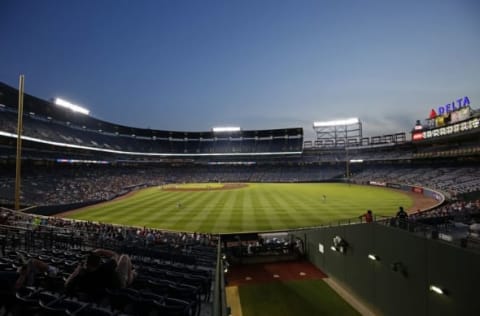
Atlanta Braves Midseason Top 50 Prospects
A Quick Primer
Welcome to Tomahawk Take’s midseason look at the Atlanta Braves top 50 prospects! This list is compiled by Benjamin Chase, writer for Tomahawk Take, through hours (upon hours upon hours upon…well, you get it) of game watching on milb.tv, conversations with scouts around the game, conversations with front office folks, and lots and lots of reading of others’ reviews on Braves prospects. This is Ben’s baby, so if you have an issue with any of the placement of the players or any such things, he’s the guy to send your hate mail to, not Fred or Jeff or Alan or any of the other talented TT writers (they have their own reasons for you to send your messages).
About the Process
I take all that info mentioned above and try to put together a list of guys based on a number of things. I will openly admit that proximity to the major leagues adds a significant bonus to a player’s value in my eyes. I’m also admittedly biased against a guy who has converted to the bullpen full-time, requiring a pretty impressive performance out of the bullpen to rank a guy very highly.
This list will not contain any players who were drafted in June or signed starting July 2nd. While I recognize that guys like Ian Anderson, Joey Wentz, Kyle Muller, and Kevin Maitan will be important pieces of the minor league system going forward, there is much that is yet to be learned about each player acquired this summer before I can accurately rank them within the system, so to have this out to you at this point before having a chance to gather that information from the sources I mentioned above, I’ll keep the midseason list free of both types and then add them in in the offseason Top 100 list (yes, that’s happening again, so start getting excited already!).
General Rules/Requests
I am more than willing to discuss alternative views on a player, but please be respectful of all posters as they post and especially the front office and team in general. This isn’t a place to air grievances about who should have been picked #3 in June or whether a certain prospect should have been part of the Cameron Maybin trade or some other discussion. We can talk all about the players mentioned, and then when I release the top 10 on Friday, I’ll also release a list of a number of other prospects that fans should be aware of that just didn’t make my list for the midseason.
With all that said, let’s take a look at today’s group – #’s 40-31!
Next: 40, 39
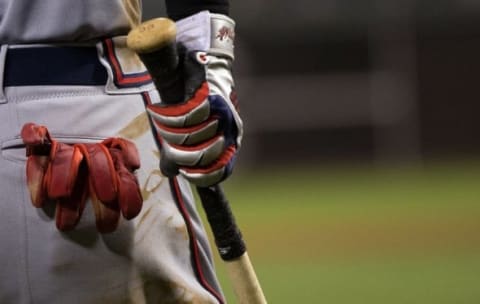
40. Alejandro Salazar, SS, Low-A Rome
Salazar was signed by the Braves out of Venezuela in 2013 with a strong defensive reputation, with many comparing Salazar to Johan Camargo, and the size comparison is obvious, as is the skill comparison. Salazar even followed Camargo’s example by putting up a big season in the DSL, going .303/.355/.361 with 4 triples and 6 steals while playing incredible defense at short and showing the type of arm that had the Braves even trying him at third base.
Last season, the Braves moved Salazar to the GCL, and he continued to play very well, hitting .284/.352/.361 with 8 stolen bases, but not a lot of power. He did show very good range at shortstop, drawing very impressive reviews when I began doing calls for my offseason top 100. One call I made put Salazar behind only Ozzie Albies defensively at shortstop in the entire system. Another said his arm was the best at the position in the entire system.
In Rome in 2016, Salazar has continued his tremendous defense, and while the power still hasn’t developed, he’s continued to show a solid contact stick, hitting .275. However, his eye that was a positive before has fallen off strongly, with a walk rate nearly half of what it was last season in the GCL. His strikeout rate has also risen by 3%, but not to any sort of unlivable level by any means.
Salazar has exhibited excellent ability to put the bat to the ball, and he’s only 19 through all of this season, so he’s playing very well in full-season ball. His glove has continued to be excellent. I worry about the lack of power in his swing as he seems to get the bat knocked out of his ball by elite velocity or hard breaking stuff. It’s a batting profile that I find similar to
Jose Perazawithout Peraza’s elite speed, but with the elite defense Peraza never had.
39. Andrew Thurman, RHP, AA Mississippi
Thurman was drafted by the Astros in the second round in 2013 after having a velocity spike in his last year of college and being a “helium” pick before the draft. He came out into the short-season A-ball league and over 39 2/3 innings had an 11/43 BB/K ratio.
He had growing pains with his new-found velocity and finding command AND control of his pitches in 2014. He did well controlling the pitches, keeping his walk rate at nearly the same level as he put up in his excellent 2013 season, however, his command of those pitches was not sharp, as he frequently missed his spot, leaving the ball in a hittable spot within the zone, and hitters were able to hit him hard, pounding balls all over the field to a 5.40 ERA.
The Braves acquired Thurman as part of the Evan Gattis trade, and they moved him to Carolina. Before the infamous bus crash, Thurman was arguably the most dominant pitcher on the entire staff, with a 2.51 ERA and a 1.20 WHIP, but even more impressive was that in half of his 6 starts before the crash, he allowed no earned runs. He missed nearly two months after the crash, and afterward, it was as if he could not find the legs under him, whether due to lingering injury or what it was, but he was never right the rest of the season.
Thurman credited his increased velocity to increased leg strength, and it’s notable in his delivery how much he relies on his legs when he’s going well. However, this season, I’ve noted that he’s been out of that “good” delivery a lot, and the results have been fairly obvious, as he’s walked nearly double any previous season. He’s still got a very good fastball that can reach 96-97 with movement along with a slider and curve that can both be effective. However, that is all predicated on him having those legs under him in his delivery, and that has simply not been the case this season.
If he can get his delivery back in line, he could very quickly move up to AAA as a reliever with power stuff, which is where his future is most likely without a major overhaul to his delivery.
Next: 38, 37

38. Luis Gamez, RHP, Danville
More from Tomahawk Take
- Atlanta Braves 2012 Prospect Review: Joey Terdoslavich
- Braves News: Braves sign Fuentes, Andruw’s HOF candidacy, more
- The Weakest Braves Homers Since 2015
- Atlanta Braves Sign Joshua Fuentes to Minor League Deal
- Braves News: New Year’s Eve comes with several questions about the 2023 Braves
Gamez was the 11th round selection of the Braves in 2014 out of high school in Arizona. The 6’2 righty was not highly regarded going into the draft, and many thought this could have been an over-draft by the team. However, Gamez did have big league bloodlines as his father was a major leaguer, and he had been clocked as high as 97 going into the draft.
Gamez pitched a total of 15 innings his senior year, and he really didn’t play much until his junior year, so he is still quite raw. So when he struggled some in his first two seasons, it was not entirely surprising, especially when he struggled with his control of his stuff.
This year has been much different. Gamez has not exactly had the best results with walks, but he has been able to keep the ball down in the zone much better this year, and his heavy fastball along with better movement on his breaking stuff has allowed Gamez to limit solid contact thus far, resulting in a 0.86 WHIP. If Gamez can continue the progress he’s made in his control and just take the next step of commanding his pitches just a touch better, he’ll rocket up the system.
37. Connor Lien, OF, AA Mississippi
The Braves drafted Lien out of high school in Florida with their 12th round selection in the 2012 draft. He was a tremendous athlete coming out of high school more than he was a baseball player, and at 6’3, 225, he may remind many of a linebacker getting off the team bus. His initial two seasons in the system exhibited that raw athleticism, as he hit for a low average with quite a few strikeouts, but blazed a path on the bases, stealing 25 in 31 attempts, and he also flashed power, hitting 6 home runs, 6 triples, and 15 doubles between the two seasons at the two rookie levels.
In 2014, he started to show some of the baseball maturity that the team was hoping would come, hitting .275/.337/.398 with 25 extra base hits and 16 steals in only 85 games with low-A Rome. His 21/84 BB/K ratio was not what you would want, but he did flash ridiculously good outfield defense that would become his calling card.
Last season, Lien had a season where all of that promise came together. He flashed power with 9 home runs and 5 triples. He definitely showed off his speed with 34 stolen bases. He even showed a more controlled swing that allowed him to get to breaking pitches better, even though he still had a tendency to go into slumps where he pulled his head off the ball and ended up tallying up loads of strikeouts in a hurry, finishing with a 33/129 BB/K ratio. On top of that, Lien showed off amazing defense. One scout told me that Lien’s arm could be the best in the entire Braves system from the outfield, and his range plus arm makes him the definite best defensive outfielder in the whole system.
Lien was injured in the first game of the season this year, and he’s taken time to get his feet under him in his return, but his numbers are starting to look a lot like last year’s, and that defense is still present. Lien is still raw in his approach, and that will have to change if he hopes to succeed at the major league level, but Lien absolutely has the upside of a guy like a
Brett Gardneras he moves through the system, and remember Gardner was also quite raw and didn’t become a full-time player in the majors until he was 26. Lien is only 22.
Next: 36, 35
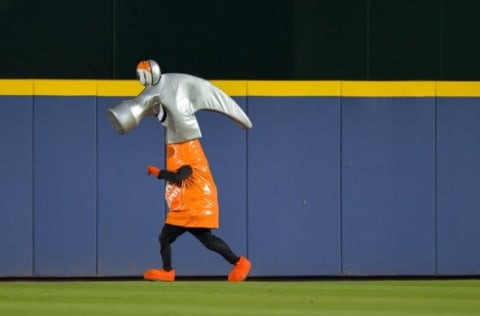
36. Carlos Castro, 1B, Low-A Rome
When Castro was signed from the Dominican Republic by the Braves in early 2012, he was viewed as an oversized catcher, which is how he got past many teams in their scouting in that area. While Castro has a strong arm, his size made the position near impossible, especially as he showed his footwork to not be up to par. After two seasons attempting to let Castro play catcher in the Dominican League (2012 and 2014 – 2013 he played only first base), the decision was made to switch him to first base full time.
The Braves brought Castro stateside and bypassed the GCL, moving him straight to Danville. There, he showed his exceptional contact skills, the skills he was renowned for in the DSL before coming stateside. However, in spite of his tremendous size, he struggled to display any size. He had .319/.340/.412 line with Danville, and he showed very solid defense at first base.
After that season, the Braves held Castro in extended spring this year, and he did not make his first appearance for Rome until late May this season. However, he came out with a leveraged swing, having dipped his back elbow to leverage his size into every swing. That has led to an increase of nearly 5% in his strikeout rate, but it also led him to be the first prospect in the Braves system to get to double digits in home runs, in spite of that late start to his season. His solid contact skills have seemingly gone to the side, but they flash every now and then. His batting average has sunk to .220-.230, but he’s one of few hitters in the whole system to sport a .500+ slugging.
Castro has still played very solid defense at first base, so if he can keep up the solid power, there will definitely be a spot for him going forward. However, due to spending the years working at catcher in the DSL, he’s already 22, so he’ll face a number of second-guessers along the way due to that age number.
35. Matt Withrow, RHP, High-A Carolina
The Braves drafted Withrow in the 6th round in 2015 out of Texas Tech. The brother of Chris Withrow, the big (6’5, 235) righty was projected to join his brother in the bullpen eventually, but the Braves started him out as a starter with Danville, and the results were so good, they kept him in the rotation this season. Withrow threw 48 innings at Danville with a 3.56 ERA and 1.33 WHIP, adding in a nice 16/35 BB/K ratio.
The Braves jumped Withrow right past Rome this year and put him in Carolina, and he’s done nothing but pitch even better than he did for Danville, with 73 1/3 innings, a 3.44 ERA, 1.39 WHIP, and a 38/74 BB/K. Withrow has consistently gone deep into games for Carolina, something they’ve received basically from just he and Enderson Franco on the season.
Withrow has big stuff, dialing his fastball into the mid-90s with plenty of sink, and he has a slider that he’s been able to play up well. The change is really going to be the divider between starter and reliever for Withrow. He’s had games when it’s on with Carolina this year, and when it’s on, he is untouchable.
His arm health is the big question as he has had some arm issues in the past. Withrow will be a tremendous asset in the system, whether he is able to work as a starter going forward or if he ends up having to move to the bullpen.
Next: 34, 33
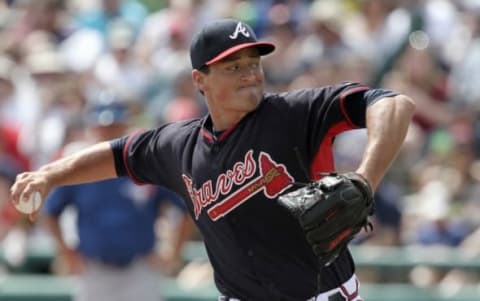
34. Tanner Murphy, C, High-A Carolina
An admitted cheeseball prospect of mine, I’d love to put Murphy much higher, but I’d have trouble arguing with folks when they question me about a sub-.200 batting average. I’d also have trouble arguing with someone who brought up a sub-20% caught stealing rate.
However, when you watch Murphy, you see more than that. Murphy was a high school football star in Missouri before the Braves drafted him in the 4th round in 2013. Murphy still has some of that raw athleticism built into his 6’1, 215-pound frame. However, he uses that athletic prowess to move well side to side on pitches, very possibly the best catcher the Braves have in their system at horizontal movement behind the plate.
Murphy also has an incredible amount of “boom” in his bat. The swing is long and heavy, but when it makes contact, it puts a ball deep. Due to his long swing, I don’t foresee Murphy ever being a guy who hits .275+, but he’s got the type of power that could translate to a 20-homer hitter, and he has tremendous defense behind the plate, along with a very good reputation at handling and working with his pitchers. Joseph Odom was hitting nearly the same until this year, and that’s very common with catchers as their bats often take longer to develop as there is a lot to adjust to behind the plate.
What Murphy does behind the plate is already mature, so it would not surprise me one bit if he is simply a year or so behind Odom in the maturation curve, but he’s also 3 years younger, so he’ll have much longer to work as well.
33. Josh Graham, RHP, Low-A Rome
Originally drafted by the Minnesota Twins as a catcher coming out of high school, Graham made the transition late in his college career to the mound, and he’s still got some raw spots in his pitching maturity. He still flashed such tremendous ability last season that many had him among the top 15-20 prospects in the entire Braves system.
After making 5 starts among 6 appearances at Danville last season after being selected in the 4th round by the Braves and posting a 2.60 ERA, 1.15 WHIP, and 3/21 BB/K over 17 1/3 innings, many thought the Braves would give Graham a run as a starter as they did guys like Matt Withrow and Patrick Weigel, drafted college arms that projected as relievers but did well as starters and remained as starters.
Instead, Graham moved to the bullpen this season, and he’s done quite well, with a 2.96 ERA, 0.90 WHIP, and 6/29 BB/K ratio over 24 1/3 innings of relief for Rome. Graham is a guy who can ride his fastball into the upper 90s, reaching as high as 97 in games I’ve viewed, and while it can straighten out plenty, he has an above average slider and a plus change that he mixes with it that keeps hitters honest, and Graham has done an excellent job of commanding all of his pitches. The projection made out of college was another converted catcher,
Jason Motte, and I do see a lot of similarity between the two.
Next: 32, 31
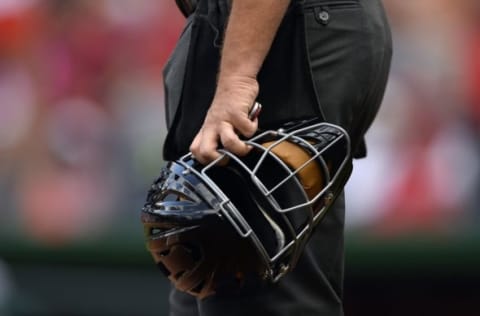
32. Lucas Herbert, C, Low-A Rome
While Murphy not too far behind will seem like perhaps too close to “elite” defensive skills like Herbert, I do see the two of them as very similar in their defensive profile. The big difference is that while both work very well with their pitchers, Herbert’s weak point is in his movement behind the plate and he has great ability to control the run game, where as Murphy is opposite.
Herbert was Kolby Allard‘s high school teammate before being selected as the Braves’ 2nd round selection in the 2015 draft. Herbert came out and made quite the impression in only 3 games before he suffered a knee injury that ended his draft year season.
The Braves moved Herbert to Rome, bypassing Danville, to start 2016, and while Herbert hasn’t exactly had an incredible season at the plate, he’s shown very good power with a number of huge hits that have been knocked down in the Rome air, and Herbert has seemingly had an “every other month” split along the way offensively. His two home runs already in July are his most in a single month, so he’s continuing to grow offensively, and the defense is already mature for a teenager behind the plate.
31. Max Povse, RHP, High-A Carolina
Many will be surprised to see Povse this early in the prospect list. This is part of two things – first, the Braves have a wealth of talent that absolutely warrants very good players down on the list this far. Second is that Povse, while starting out very well in April, has struggled with what has been his undoing in the past throughout the season, including his first start with AA.
I mentioned in my scouting report on Povse in February that Povse’s lanky 6’8 frame leads to him getting off in his landing spot with his front leg, and then that would affect his release point.
Early this season, we saw the best of Povse. When his release point is on, his fastball plays up as his big frame allows him to get on top of the ball, creating a solid plane, and his change plays strongly off of his fastball. Povse is a very good control pitcher, but where he struggles is when he loses that release point, his command can get off, and he will lose that solid plane on the fastball, which sits in the low-90s, touching 95. Most professional hitters can do work with a 95 MPH straight fastball in the zone if they’re aware the pitcher will be around the zone.
Povse started this season showing that good control of his mechanics, and his April stat line showed it, with a 1.69 ERA and 0.71 WHIP in 26 2/3 innings. However, from the 1st of May forward, he has posted a 4.73 ERA and 1.41 WHIP with a 13/72 BB/K ratio, and it has been notable to see that his curve has maintained the sharp break that he tended to lose when he was struggling with his landing point last season, but his fastball has straightened out, and while he has solid control, his command in the zone has suffered badly on the fastball and change, and he’s been hit hard since.
Povse will be given an opportunity to produce as a starter with Mississippi this season, and I’ve certainly been shown wrong when doubting the timing of a promotion before – see: Lucas Sims last season, but I believe we’ll see the move of Povse to the bullpen as soon as this fall/winter.
Next: Braves Minor League Database